

How the So-Called "Alt-Right" Went From the Fringe to the White House. Stephen Bannon.
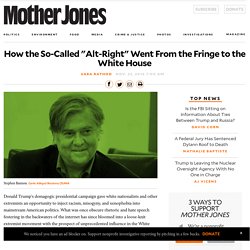
Carlo Allegri/Reuters/ZUMA Donald Trump's demagogic presidential campaign gave white nationalists and other extremists an opportunity to inject racism, misogyny, and xenophobia into mainstream American politics. What was once obscure rhetoric and hate speech festering in the backwaters of the internet has since bloomed into a loose-knit extremist movement with the prospect of unprecedented influence in the White House.
Here's how it happened. (Also read our full investigation into the extremist movement seeking to capitalize on Trump's victory.) Right-wing firebrand Andrew Breitbart creates Breitbart News as an antidote to "liberal bias" in media. White nationalist Richard Spencer coins the term "alt-right," initially to describe anti-establishment right-wingers skeptical of Bush-era Republicans. Andrew Breitbart dies of heart failure. Long read: Why Canada has a labor party and the US does not. In this year’s Democratic presidential primary, Bernie Sanders ran as a Democrat, despite describing himself as a ‘socialist’.
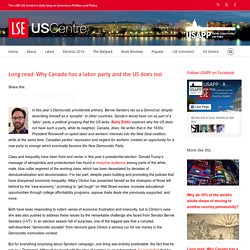
In other countries, Sanders would have run as part of a ‘labor’ party, a political grouping that the US lacks. Barry Eidlin explores why the US does not have such a party, while its neighbor, Canada, does. He writes that in the 1930s, President Roosevelt co-opted labor and workers’ interests into the New Deal coalition; while at the same time, Canadian parties’ repression and neglect for workers’ created an opportunity for a new party to emerge which eventually became the New Democratic Party. Class and inequality have been front and center in this year’s presidential election. Donald Trump’s message of xenophobia and protectionism has found a receptive audience among parts of the white, male, blue collar segment of the working class, which has been devastated by decades of deindustrialization and deunionization.
Is a US labor party impossible? What changed? As Trump delivers his Gettysburg address, Republicans prepare for a civil war. GETTYSBURG, Pa. — Anne O’Reilly, a lifelong Republican activist, was in the audience here waiting for Donald Trump to arrive Saturday morning.
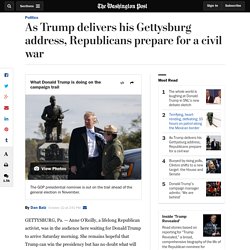
She remains hopeful that Trump can win the presidency but has no doubt what will happen if he doesn’t. “I think it’s going to be an eggbeater in the Republican Party,” she said. “I think you’re going to see pieces going all over the place.” Trump came to Gettysburg to deliver what his campaign billed as a closing argument for the presidential campaign, to lay out plans for the first 100 days of a Trump administration and, citing Abraham Lincoln’s famous address here in 1863, to restore a government of, by and for the people.
What Republicans and Democrats have disagreed on, from 1856 to today - Washington Post. Lessons for 2016 from the smashup of the Second Party System and the War of the Whig succession. The rise of Donald Trump has caused many to predict that the Republican Party as we know it is on the verge of self-destruction.
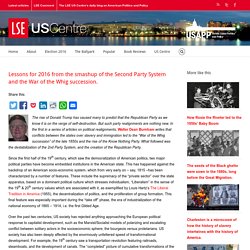
But such party realignments are nothing new. In the first in a series of articles on political realignments, Walter Dean Burnham writes that conflicts between the states over slavery and immigration led to the “War of the Whig succession” of the late 1850s and the rise of the Know Nothing Party. What followed was the destabilization of the 2nd Party System, and the creation of the Republican Party. Since the first half of the 19th century, which saw the democratization of American politics, two major political parties have become embedded institutions in the American state. This has happened against the backdrop of an American socio-economic system, which from very early on – say, 1815 –has been characterized by a number of features. Realignments Flag of the Know Nothing Party Credit: Shaun (Flickr, CC-NC-SA-2.0) Shortened URL for this post:
How did the dramatic election of 1968 change U.S. politics? This new book explains. The Rev.
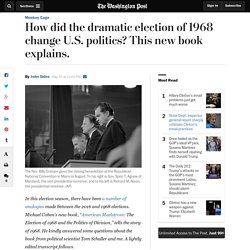
Billy Graham gives the closing benediction at the Republican National Convention in Miami in August. To his right is Gov. Spiro T. Agnew of Maryland, the vice presidential nominee, and to his left is Richard M. Nixon, the presidential nominee. In this election season, there have been a number of analogies made between the 2016 and 1968 elections. Why write a book about 1968 now? Michael Cohen: First and foremost, this was an amazing election with an assemblage of political talent unlike anything we’ve ever seen in American politics – Lyndon B.
And then you had so many incredible events that year: The Tet offensive, Eugene McCarthy almost beating LBJ in New Hampshire, Robert Kennedy challenging LBJ for the nomination, LBJ dropping out a few weeks later, the assassinations of Robert Kennedy and Martin Luther King Jr., the riots outside the Democratic convention in Chicago. But the bigger issue is that 1968 represented a clear inflection point in American politics. Thomas Piketty on the rise of Bernie Sanders: the US enters a new political era. How can we interpret the incredible success of the “socialist” candidate Bernie Sanders in the US primaries?
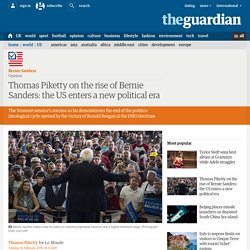
The Vermont senator is now ahead of Hillary Clinton among Democratic-leaning voters below the age of 50, and it’s only thanks to the older generation that Clinton has managed to stay ahead in the polls.
The Democrats are radical, divided and just as messed up as the Republicans. Sorting. Republicans. Two party system? Third parties and independents. Party decline/party renewal. Polarization.